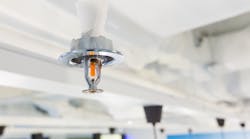By Mark Fessenden – Director, Industry Relations, Johnson Controls
The most effective means of combating a fire in a residential occupancy is a properly designed, installed, and maintained fire sprinkler system. These systems use automatic fire sprinklers that individually react to the heat generated from an uncontrolled fire, releasing water upon activation. Each activated sprinkler discharges about 15 gallons of water every minute, helping to save lives, limit property damage, and reduce risk while local responders are in route.
Today, more jurisdictions are recognizing that automatic fire sprinkler systems are key elements in an effective strategy to keep their communities safe. Because of this, automatic fire sprinkler system installations in single- and multi-family dwellings is becoming more commonplace. This includes communities in colder regions, where one area of concern involves the freeze protection of water-filled fire sprinklers systems. Fortunately, there are several strategies that can be used to address these concerns efficiently and effectively.
Options for Freeze Protection
The National Fire Sprinkler Association provides guidance on fire sprinkler system design, installation, and maintenance which includes guidance on how to address freezing concerns. Within that guidance, they provide four options:
· The first option is to design a sprinkler system where all the piping is installed within interior heated walls or between floors. One downside of this is that modern open floor plans may limit where this strategy can be used.
· Another option is the use of insulation to create a heated pocket where piping can be installed. This is not a perfect solution, because in colder areas the insulation may not be sufficient to prevent the transfer of freezing temperatures to the piping.
· Dry pipe sprinkler systems are also an option. This involves filling a system with a pressurized gas that holds back water, only releasing water into the piping once an automatic sprinkler activates. Since water must reach the activated sprinkler within 15 seconds, this can limit the size of the system or occupancy.
· The final and increasingly more popular option is the use of a specially listed antifreeze solution within the piping to prevent freezing. Sold as a pre-mixed solution, a properly tested and listed antifreeze helps protect against freeze damage failure and ensures flow in wet fire sprinkler systems.
Choosing the Right Antifreeze
The most effective antifreeze solutions are engineered and formulated for use in a variety of applications where a sprinkler system could be exposed to temperatures below 40°F, in both residential and commercial applications. This includes parking garages, garden centers, loading docks and other exposed or unheated spaces. To help protect these spaces in the harshest climates, manufacturers are now offering antifreeze solutions that perform at temperatures as low as minus 25°F. This is especially beneficial in the northern United States and Canada where average temperatures can dip below minus 15°F.
Antifreeze solutions are tested and certified to UL 2901, which evaluates fire performance, stability, compatibility with other sprinkler system components, human health and environmental impact, and hydraulic characteristics. UL Listed antifreeze solutions are suitable for use with most common piping system materials, including CPVC. There are nontoxic solutions available with the FDA classifying them as "generally recognized as safe" (GRAS) for disposal in septic systems and public sewer systems.
When selecting an antifreeze solution, it is very important to use a product that is third-party tested and evaluated. In fact, the National Fire Protection Association (NFPA) requires the use of listed solutions in new antifreeze systems. Existing antifreeze systems must meet this requirement by 2022 under NFPA 25.
Whether you are a contractor, fire authority, or a building or homeowner, there are a variety of benefits when using UL Listed antifreeze. It is an easy, safe, cost-effective and trusted way of dealing with freezing temperatures as low as minus 25°F in fire protection systems, especially when compared to other freeze protection methods that can be more complicated to install and maintain. Automatic fire sprinkler systems combined with a UL Listed antifreeze are an efficient and effective solution to combat fires in residential occupancies, helping to save lives and protect property.
Mark Fessenden is Director of Industry Relations for Johnson Controls Inc. For more than 20 years, Fessenden has worked in Fire Protection Equipment Manufacturing. His focus has been in the development of new technologies, codes & standards, technical services, and training. He holds 3 U.S. patents in automatic sprinkler technology. Mark is NICET certified in Automatic Sprinkler System Layout and Special Hazard Suppression Systems. He is a member of the Society of Fire Protection Engineers, National Fire Sprinkler Association, and American Fire Sprinkler Association, active nationally and locally.


